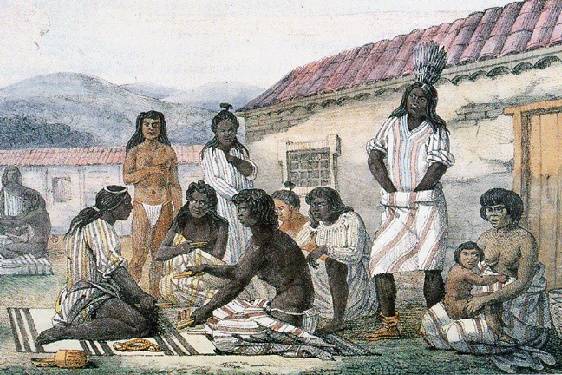California Indians and the Land: Difference between revisions
No edit summary |
m (1 revision(s)) |
(No difference)
| |
Revision as of 15:09, 7 October 2007
Indians at a Mission
The indigenous inhabitants of San Francisco used more than 150 different plant species in addition to dozens of animal species to provide for their needs (Bocek 1984). Thoughtful management by the Yelamu helped foster the abundant and diverse native plant communities on which they depended. Willows, for example, needed pruning to encourage the straight young poles preferred by basketweavers. Fire was perhaps their most potent management tool, as it prevented shrub encroachment on grasslands rich in edible bulbs and kept the landscape open for deer (Anderson 1993). One visitor recorded fires while camping near Mission Dolores in late October 1816. "All night," he wrote, "great fires burned on the land at the back of the harbor; the natives are in the habit of burning the grass, to further its growth" (Chamisso 1816).
Centuries of such management had a dramatic effect on the landscape, but the changes were not immediately apparent to the Europeans who first visited Yelamu territory. The bounty of this managed landscape was the currency in the first recorded exchange of gifts between the Spanish visitors and the Yelamu. On a March day in 1776 two Yelamu men visited the Spanish camp at Mountain Lake and brought firewood, probably harvested from live oaks (Bolton 1931).
A few days later, when Juan Agustn Bautista de Anza selected a site for the future presidio or fort, he chose an open mesa with dramatic views in all directions. He was witnessing an inhabited landscape, kept open by the Yelamu to meet their need for diverse natural products. Without their fires, the flower-studded grasslands noted by Anza and his associates probably would have reverted to dense maritime chaparral dominated by ceanothus (Ceanothus thyrsiflorus), blackberry (Rubus ursinus), and poison oak (Toxicodendron diversilobum). After several centuries without fire, these scrub species are dominant along the western edge of the Presidio, but when Father Pedro Font walked around the area with Anza during the spring of 1776, he recorded a very open mesa studded with an abundance of wild violets. Font had marveled at the plentiful wildflowers near his campsite on the shore of Mountain Lake. There are yerba buena [Satureja douglasii] and so many lilies, he wrote, that I had them almost inside my tent (Bolton 1931). The views on the mesa were tremendous, his dreams for the land ambitious.
This mesa affords a most delightful view, for from it one sees a large part of the port and its islands, as far as the other side, the mouth of the harbor, and of the sea all that the sight can take in as far as beyond the Farallones. . . . If it could be well settled like Europe there would not be anything more beautiful in all the world, for it has the best advantages for founding in it a most beautiful city.
This mesa of superlatives was the result of centuries of interaction between powerful natural and cultural processes. The deer and elk, the wind and fog, the willow pruning and fire startingall had contributed to the very green and flower-covered mesa encountered by Font (Bolton 1931). The panoramic views that Font considered so breathtaking are now blocked by buildings and trees.
Pete Holloran
Contributors to this page include:
California Historical Society,San Francisco,CA - Publisher or Photographer
Choris,Louis - Photographer-Artist
Holloran,Pete - Writer
Holloran,Pete - Writer

